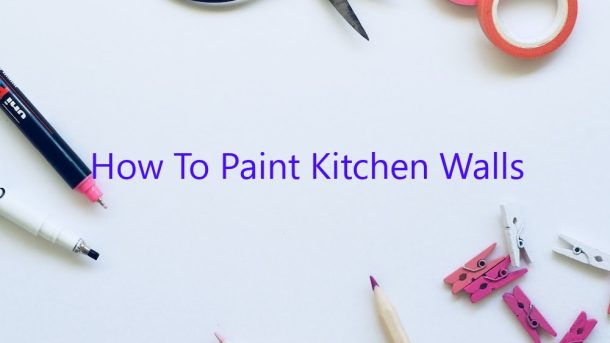When it comes to painting your kitchen walls, there are a few things you need to keep in mind. In this article, we will go over the basics of how to paint your kitchen walls, including what type of paint to use and what tools you will need.
The first step in painting your kitchen walls is to choose the right paint. In most cases, you will want to use an enamel paint, as it is durable and easy to clean. However, if you are looking for a more decorative finish, you may want to consider using a latex paint instead.
Once you have chosen the right paint, the next step is to prepare the walls. This involves cleaning the walls and removing any dust or debris. You may also need to repair any cracks or holes in the wall before you begin painting.
Once the walls are prepared, it is time to start painting. The best way to do this is to start in one corner and work your way around the room. Be sure to use even strokes and to avoid painting over the same area multiple times.
It usually takes two or three coats of paint to achieve the desired results, so be sure to allow enough time for the paint to dry between coats. Once the paint is fully dry, you can begin to enjoy your new kitchen walls!
Contents
How do you prepare a kitchen wall for painting?
Painted walls can add color and personality to a kitchen, but first the walls must be prepared for painting. This process includes removing any old paint and cleaning the surface so the new paint will adhere properly.
First, use a putty knife to remove any loose paint or wallpaper. Be sure to scrape any areas that are bubbling or peeling. If the surface is stained, use a primer to cover the stain.
Next, use a cleaning solution to remove any dirt or grease from the surface. A solution of TSP (trisodium phosphate) and water will work well, but be sure to follow the instructions on the TSP carefully.
Finally, use a primer to prepare the surface for painting. A primer will help the paint to adhere to the surface and will help to prevent stains from showing through the paint.
What kind of paint do you use on kitchen walls?
When it comes to painting your kitchen walls, there are a few different things to consider. The first is the tone of the paint. You’ll want to choose a color that complements the overall style and design of your kitchen.
Another thing to think about is the type of paint you use. There are a few different options, and each has its own benefits and drawbacks. One option is latex paint. Latex paint is easy to apply and is relatively affordable. It also dries quickly and is resistant to moisture.
Another option is oil-based paint. Oil-based paint is more durable than latex paint and can be used on both interior and exterior surfaces. However, it is more expensive and takes longer to dry.
If you’re not sure which type of paint to choose, consult with a professional painter. They can help you choose the right type of paint for your kitchen and give you tips on how to apply it.
Do I need to sand the kitchen walls before painting?
Yes, you should sand the kitchen walls before painting them. Sanding the walls will help the paint adhere better and will give the walls a smoother finish.
There are a few things to keep in mind when sanding kitchen walls. First, make sure to use the right type of sandpaper. Coarse sandpaper is best for removing paint and other debris, while fine sandpaper can be used to create a smooth finish.
Second, be careful not to sand the walls too harshly. You don’t want to remove too much of the paint or the surface of the wall. Sand the walls in a circular motion, and take your time to ensure a smooth finish.
Finally, always test a small area of the wall before painting it. This will help you to ensure that the paint will adhere properly and that the wall is sufficiently sanded.
Do you have to prime kitchen walls before painting?
Do you have to prime kitchen walls before painting?
The answer to this question is a little bit complicated. In general, you do not have to prime kitchen walls before painting them. However, if your kitchen walls are in bad condition, you may want to prime them before painting.
If your kitchen walls are in good condition, you can probably just paint them without priming them. However, if your kitchen walls have any stains or blemishes, you may want to prime them before painting. Priming will help to cover up any imperfections on your walls and will help your paint to look more uniform.
If your kitchen walls are in bad condition, you may want to consider priming them before painting. Damaged walls can be difficult to paint and can often look patchy. Priming your walls before painting can help to improve the overall appearance of your kitchen.
Ultimately, whether or not you should prime your kitchen walls before painting depends on the condition of your walls. If your walls are in good condition, you can probably get away with just painting them. However, if your walls are in bad condition, priming them before painting is likely to produce better results.
Do you need a primer on kitchen walls?
If you’re planning to paint your kitchen walls, you may be wondering if you need to apply a primer first. In most cases, the answer is yes. A primer will help the paint adhere better to the wall and will also help to hide any imperfections in the surface.
There are a few exceptions, however. If your kitchen walls are made from a very smooth surface, such as tile or vinyl, you may not need a primer. In most cases, however, it’s a good idea to use one anyway.
If you’re not sure whether or not you need a primer, it’s best to err on the side of caution and apply one. Primers are inexpensive and easy to use, so there’s no reason not to use one if it’s needed.
Do painters clean walls before painting?
Do painters clean walls before painting?
The answer to this question is yes, most painters will clean the walls before painting. This is because it is important to remove all the dirt, dust, and debris from the walls so that the paint will adhere properly. If the walls are not clean, the paint can start to peel and chip off.
There are a few different ways that painters can clean the walls. Some painters will use a pressure washer to blast the walls clean. Others will use a sponge and a bucket of water to clean the walls. And finally, some painters will use a combination of both methods.
It is important to note that not all painters will clean the walls before painting. If you are hiring a painter, be sure to ask them if they will clean the walls before painting. If they do not, you may need to hire a separate company to clean the walls before the painter arrives.
Do you need special paint for kitchen?
When it comes to painting your kitchen, you may be wondering if you need special paint. The truth is, you don’t necessarily need special paint for your kitchen, but there are a few things to keep in mind.
For one, kitchen paint should be durable and withstand heat and humidity. Secondly, it’s important to choose a paint that is easy to clean, as kitchens can be messy places. Finally, it’s a good idea to select a paint that is resistant to stains and fading, as these can be common problems in kitchens.
If you’re looking for a paint that meets all of these requirements, you may want to consider a kitchen paint specifically designed for the task. These paints can be found at most home improvement stores, and they come in a variety of finishes, including glossy and matte.
If you’re not interested in using a kitchen-specific paint, there are a few things you can do to make your regular paint more durable. One option is to add a sealant to your paint job. This will help to protect your paint from moisture and humidity. Another option is to use a high-quality paint meant for high-traffic areas, such as a kids’ room or a hallway.
No matter what type of paint you choose, it’s important to keep in mind the specific needs of your kitchen. With the right paint, your kitchen can look great and be easy to keep clean!




